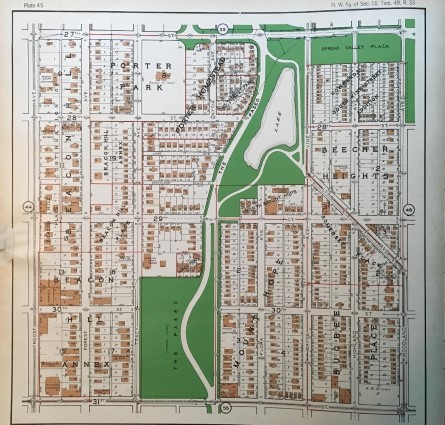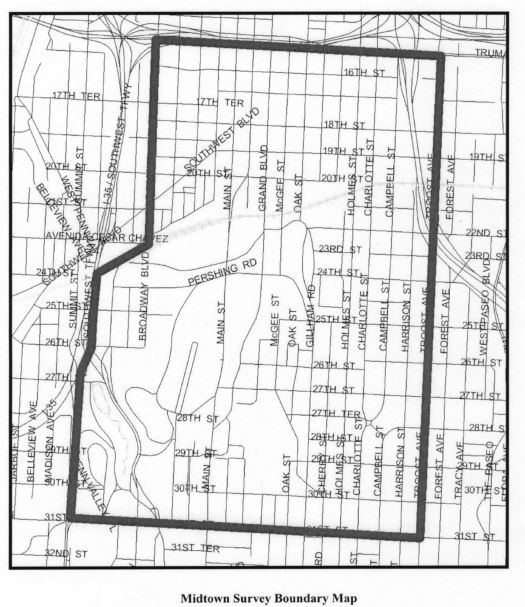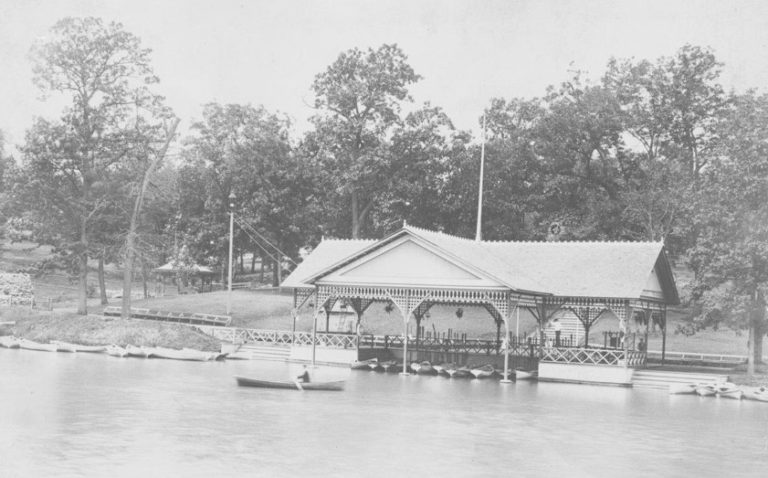HISTORIC CHARACTER OF THE AREA
Recently, there have been serious efforts to catalogue and document the historic character of buildings and geographic artifacts of what we are calling the Porter Farm District.
The Porter Farm itself originally extended west as far as what is now McGee Trafficway. On the western edges of the farmstead, the areas now known as Union Hill and Crown Center evolved. Beginning in March, 1981 and ending in July, 1985, the City of Kansas City, Missouri, with grant assistance from the Missouri Department of Natural Resources, Division of Parks and Historic Preservation, conducted a historic survey of the area bounded on the north at 15th Street to 31st Street on the south, and from Troost on the east to the Southwest Trafficway on the west. This 5½ square mile area embraced a substantial portion of the Porter Farm Homestead.
The survey found there were approximately eighty extant buildings within its area (including part of the Porter Farm) still standing from the early 1900's. One of the oldest buildings surveyed was a residence located at 2300 Troost. The story brick residence at 2300 Troost was built in 1883. Unfortunately, it has since been demolished and lost to redevelopment of a hotel in what is now called Beacon Hill.
Many other historic buildings existed in the area until recently, many being demolished in the name of “urban redevelopment”. For example, the Midtown Survey found that in 1899, a portion of the original Porter estate that had been used for many years as pasture (lying between 27th and 29th Streets, Harrison and Charlotte) was platted as the Hill Crest Addition.
George Kessler, the famous landscape architect for the Board of Park and Boulevard Commissioners (his designs including today’s Paseo Boulevard and Ward Parkway), and Stephen A. Mitchell laid out the subdivision. (?) They avoided the regular street grid pattern and allowed the streets to curve in order to follow the natural topography. Two circular pieces of ground, dedicated to public use, are sited in traffic circles in the subdivision where curving streets that still exist today intersect. Most of the construction in this subdivision occurred in the first two decades of the 20th century.

1925 Atlas Map of a section of the Porter Farm District, the Troost Park Area

Just to the south of the Hill Crest subdivision is what was once known as the Beacon Hill Park subdivision, platted in 1887. Many of the residences in this subdivision were constructed in the l 890's and many exhibited Queen Anne stylistic elements (2832, 2839, 2900, 2906, 2910, and 2914 Campbell; 2815, 2817, 2822, 2825, 2828, 2900, 2904, 2912, and 2915 Charlotte; and 2832 Harrison.
An especially noteworthy residence of this period is the Frank P. Burnap residence that still stands at 2924 Harrison, constructed in 1896. Burnap was the founder of the F.P. Burnap Stationery and Printing Company and was a noted collector of antique English pottery. The large two story brick residence features a variety of ornamental elements and ornate dormer treatment. Several other residences from this decade still stand and are scattered throughout the southern portion of Porter Farm Historic Preservation Project area.
Several houses in the present day Union Hill neighborhood, also within the boundaries of the Porter Farm District, were constructed in the 1890's, primarily on the 3000 blocks of Walnut and McGee Streets. In 1898-99 a group of houses was built on DeGroff Way for William Rockhill Nelson was one of his earliest ventures in residential development. Rather than face the north-south street, these houses are sited so that each faces south onto a broad expanse of lawn. In 1897, the estate of Thomas Corrigan, another famous Kansas Citian, constructed a row of two story brick residences on the 2500 block of Holmes. Some of the original eight residences remained today.
Troost Lake Designed to Encourage Streetcar Use
Source: Jackson County Historical Society newsletter, Vol. 47, No. 1, spring 2006
In the 1880s, Kansas City was booming. As part of that growth, cable car lines were laid to several parts of the city. The first cable line built ran from Union Depot in the West Bottoms to 8th Street and Woodland. It opened in July 1886.
The system was expanded, and on 18 November 1887, the Kansas City Cable Railway Company opened its Troost Avenue line. This line ran from 8th Street and Troost Avenue, south to Springfield Ave., (now 31st Street), in what was then the outlying suburbs of Kansas City. One of the owners, William J. Smith, a West Bottoms implement dealer, lived in a big sandstone house on the southeast corner of 30th Street and Troost.
To develop the traffic for the Troost line, the Kansas City Cable Railway Company decided to create Troost Park. Many similar “trolley parks” came into existence across the country to increase patronage for the newly built street car lines.
The Kansas City Cable Railway owned six acres at the site, and leased twenty-five more acres from Mrs. Lucy Porter, a widow, and her two sons, James. B. Porter and J. Lee Porter. The tract was part of the original Porter Farm, which the Reverend James Porter, a Methodist minister, acquired in 1834.
On April 19, 1886, the Porters sold a 15-acre strip extended from the alley between Holmes and Charlotte Streets along 29th Street to Tracy Avenue for $67,500.
In 1888, Troost Park opened. The entrance was at 29th Street and Tracy, one block from the Troost cable line. (There was also a private gate at the northeast corner of 28th Street and Tracy; it was the entrance from the Porter Farm.) The park occupied a rectangular tract running from 27th Street to Springfield Avenue (31st Street). It ran from Tracy Avenue on the west to Grove and Vine Street on the east.
The cable railway also built a refreshment booth at the southeast corner of 29th Street and Troost Avenue, where sandwiches, popcorn, and soda pop were sold. A high, white picket fence enclosed the park. And, a bell hung over the entrance gate which rang at 11 o’clock in the evening to signify the park’s closing. A manmade lake was created between 27th and 29th Streets from Vine to Grove Street.
The first mention of the new Troost Park surrounded the 1888 Fourth of July celebrations:
The Kansas City Cable Company’s park on south Troost Avenue received a full quota of pleasure-seekers. The labor picnic was held there and hundreds of working men, with their wives and family, ate their noon meal in the shade of beautiful trees. All during the afternoon, a constant stream of people, anxious to escape the noise, poured in at the gates. The only amusement at the park was dancing. An impromptu-dancing pavilion had been erected and three fiddlers and a cornet player sawed away while the younger ones danced and perspired and perspired and danced. The most of the crowd, however, seemed content to remain under the trees and enjoy the shade, with an occasional trip to the spring for cool draughts. The Troost Avenue cars were crowded nearly all day, and the company reaped a big harvest from the exodus from the city. Dozens went out to the car in carriages and spent the day there. 1
In 1889, more attractions were added, including dancing, music, boat races, and a grand Fourth of July Celebration at Troost Park.! 2
The park's third season, 1890, saw the addition of swimming races, in addition to boat races, dancing and music. Fireworks displays were also added.
In 189, Troost Park offered free admission for the Fourth of July holiday. In just three years, the new park had added several attractions: a shooting gallery, bowling alley, merry-go-round, fountains, and animal cages.
In 1892, the Switchback Railway was added, the first in Kansas City. The Switchback Railway, forerunner of today's roller coaster, was invented in 1884 by LaMarcus Thompson and first installed at Coney Island, near New York City. It was an immediate sensation and he started grossing $700 a day. Two years later, Thompson built the first fully developed roller coaster at Atlantic City. Although the Switchback Railway was the first amusement ride in Kansas City, the only mention found of the Switchback Railway at Troost Park, save for an undated brochure in the Jackson County (Mo.) Historical Society's archival collections, is in newspaper advertisements in 1892, 1893 and 1894.
The end of Troost Park as an amusement park also saw the farewell to The Banda Rosa directed by Eugenio Sorrentino.3 Admission to the park was ten cents.
After the 1902 season, the City of Kansas City purchased Troost Park and turned it into a city park. The new Paseo Boulevard was extended through the park. Today, Troost Park remains a Kansas City park. Troost Lake recently gaincd notoriety as a possible crime scene necessitating it being drudged and drained for investigation. Sadly, little else remains today to remotely suggest that Troost Park was Kansas City's first true amusement park.
1 Kansas City (Mo.) Journal, 5 July 1888.
2 Kansas City (Mo.) Star, 3 July 1889.
3 Kansas City (Mo.) Star, 31 August 1902 1902. The advertisement noted it was the Band's third season in Kansas City.

